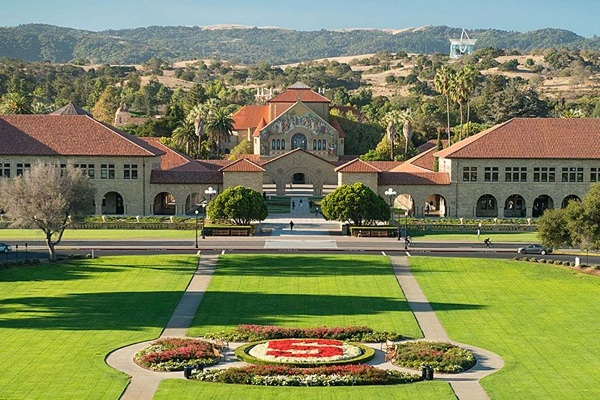Introduction
Stanford University, located in the heart of Silicon Valley in Stanford, California, is one of the most prestigious and competitive institutions in the world. Renowned for its academic excellence, cutting-edge research, and vibrant campus life, Stanford consistently ranks among the top universities globally. Students from around the world aspire to gain admission to this elite institution, drawn by its strong academic programs, entrepreneurial spirit, and proximity to leading tech companies like Google, Apple, and Meta.
In this comprehensive guide, we’ll explore the complete admission process, visa requirements for international students, the wide range of courses Stanford offers, and the associated tuition fees.
About Stanford University
Founded in 1885 by Leland and Jane Stanford in memory of their only son, Stanford University has grown into a global leader in education, research, and innovation. The university boasts:
- 7 Schools (including Business, Engineering, Law, Medicine, and Humanities & Sciences)
- Over 16,000 students from across the globe
- A sprawling 8,180-acre campus
- Nobel laureates, Turing Award winners, and MacArthur Fellows among faculty and alumni
Stanford is particularly noted for its entrepreneurial culture and its alumni network, which includes the founders of Google, Hewlett-Packard, Instagram, and LinkedIn.
Admission Process at Stanford University
1. Types of Programs Offered
Stanford University offers admissions in the following academic categories:
- Undergraduate Programs (Bachelor’s Degrees)
- Graduate Programs (Master’s and Doctoral Degrees)
- Professional Programs (e.g., MBA, MD, JD)
2. Undergraduate Admission Process
Application Portal: Common Application (https://www.commonapp.org)
Application Components:
- Completed Common Application
- Stanford-specific Questions
- ACT or SAT scores (Optional for 2024–25 admissions)
- High School Transcripts
- Two Teacher Evaluations
- School Report and Counselor Recommendation
- Mid-Year Report
- Application Fee: $90 (can be waived for eligible students)
- Supplemental Materials (optional: arts portfolio)
Important Deadlines:
- Restrictive Early Action: Deadline – November 1
- Regular Decision: Deadline – January 5
- Decisions Released: April
Acceptance Rate:
Stanford’s undergraduate acceptance rate is around 3.9%, making it one of the most selective in the world.
3. Graduate Admission Process
Graduate admissions vary by department but generally follow a centralized online application process via https://gradadmissions.stanford.edu/
Application Requirements:
- Online Application
- Statement of Purpose
- Letters of Recommendation (3)
- Official Academic Transcripts
- Standardized Tests (GRE/GMAT/LSAT/MCAT depending on program)
- English Language Proficiency: TOEFL or IELTS for international students
- Application Fee: $125
Graduate Schools at Stanford:
- School of Engineering
- Graduate School of Business
- School of Law
- School of Medicine
- School of Education
- School of Earth, Energy & Environmental Sciences
- School of Humanities & Sciences
Visa Process for International Students
International students admitted to Stanford University need to obtain an appropriate student visa (usually F-1 or J-1).
Step-by-Step Visa Process:
- Receive I-20 or DS-2019: After confirming enrollment and submitting financial documents, Stanford issues an I-20 (F-1 visa) or DS-2019 (J-1 visa) form.
- Pay SEVIS Fee:
- SEVIS I-901 Fee: $350 for F-1 or $220 for J-1
- Pay at fmjfee.com
- Apply for a U.S. Visa:
- Fill DS-160 form online
- Schedule a visa interview at the nearest U.S. embassy or consulate
- Pay the visa application fee ($185)
- Attend Visa Interview: Carry documents including:
- Valid passport
- Form I-20 or DS-2019
- Visa fee receipt
- SEVIS fee receipt
- Academic transcripts
- Proof of financial support
- Visa Approval and Travel: Once approved, students can enter the U.S. up to 30 days before the program start date.
Courses Offered at Stanford University
Stanford offers a broad range of undergraduate and graduate programs across various disciplines.
1. Popular Undergraduate Majors:
- Computer Science
- Human Biology
- Economics
- Engineering (Electrical, Mechanical, Civil, etc.)
- Psychology
- Political Science
- Symbolic Systems
- International Relations
2. Top Graduate Programs:
- MBA (Graduate School of Business)
- MS/PhD in Computer Science, AI, Data Science
- MS in Mechanical and Electrical Engineering
- JD (Law)
- MD (Medicine)
- Education Leadership and Policy
- Earth Systems and Environmental Science
3. Interdisciplinary Programs:
- Biomedical Informatics
- Neurosciences
- Bioengineering
- Sustainability and Environmental Management
- Computational and Mathematical Engineering
Tuition Fees and Living Expenses
Undergraduate Costs (2024–2025):
| Category | Annual Cost |
|---|---|
| Tuition | $62,484 |
| Room and Board | $20,398 |
| Books and Supplies | $1,350 |
| Personal Expenses | $2,355 |
| Health Insurance | $7,128 |
| Total Estimated Cost | $93,715 |
Note: Stanford offers need-based financial aid and generous scholarships to eligible students, including international students.
Graduate Program Fees:
Tuition for graduate students varies by department and number of enrolled units. Here are some averages:
| Program | Annual Tuition |
|---|---|
| MS in Engineering | $59,000 – $62,000 |
| MBA (GSB) | $82,000 |
| Law (JD) | $72,000 |
| Medicine (MD) | $66,000 |
| Humanities & Sciences (MA/PhD) | $50,000 – $65,000 |
Living Costs (Graduate Students):
- Housing & Food: $20,000 – $25,000/year
- Books, Insurance, Personal Expenses: $10,000 – $12,000/year
- Total Estimated Cost: ~$75,000 – $95,000/year
Stanford provides graduate funding through assistantships, fellowships, and external scholarships.
Scholarships and Financial Aid
For Undergraduate Students:
- Need-Blind Admissions for U.S. citizens and permanent residents
- Need-Aware for international students
- Full scholarships available for families with income under $100,000
- Partial aid available for incomes up to $200,000+
For Graduate Students:
- Research and Teaching Assistantships (RA/TA)
- Stanford Graduate Fellowships
- Knight-Hennessy Scholars Program: Full funding for international and U.S. students
- External funding like Fulbright, DAAD, and Chevening
Campus Life and Student Opportunities
- Clubs and Societies: Over 600 student organizations
- Athletics: NCAA Division I teams, state-of-the-art gyms
- Entrepreneurship: Access to Stanford’s StartX Accelerator, venture funding
- Global Exposure: Overseas programs, internships, and research collaborations
Why Choose Stanford?
- Academic Excellence: Globally ranked among the top 5 universities
- Proximity to Tech Giants: Internships, mentorship, and job opportunities
- Interdisciplinary Learning: Flexible programs across fields
- Prestigious Alumni Network: Bill Gates, Elon Musk, Larry Page, and more
- Innovative Campus Culture: Maker spaces, AI labs, sustainability centers
Conclusion
Getting into Stanford University is a dream for many—and with good reason. The university not only offers world-class education and global networking opportunities but also encourages innovation, leadership, and impact. Though the application and visa process can be competitive and complex, the rewards of a Stanford education are immeasurable.
Whether you’re an aspiring engineer, entrepreneur, scientist, doctor, or social leader, Stanford provides the platform, resources, and inspiration to help you shape the future. With thoughtful planning, strong academics, and a clear vision, your journey to Stanford can become a reality.

